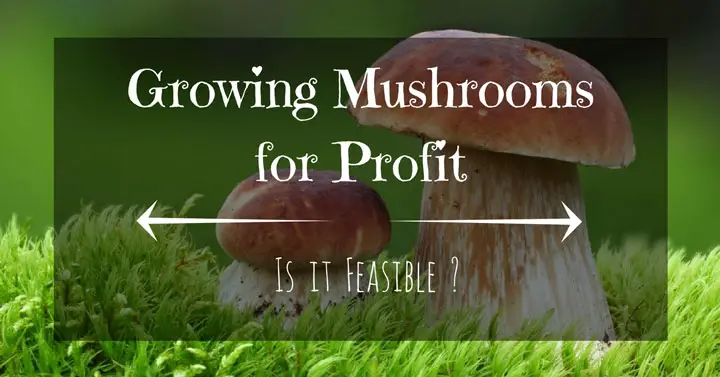Growing Mushrooms for Profit, Is it Feasible?
Mushrooms are considered a high-value crop and their popularity as a specialty food continue to grow over the years. Mushrooms have flavor and texture that are distinct from meat or vegetables. No wonder many people love them. With an increasing demand for these fungi, small and big-time businesses saw a good opportunity in growing mushrooms for profit.If you are considering this path, this guide is just for you.
More...
Growing Mushroom is Easy
Helpful guides in growing mushrooms are widely available online. That makes growing mushrooms easier. Typically, you’ll just need to prepare the materials and follow the correct procedure and you can almost be sure to get a high yield.
Moreover, in growing mushrooms, you can easily control the factors that affect their growth including the humidity, light and temperature. Maintaining their growing conditions can give you a steady harvest all year-round. Best of all, you don’t need a large area to grow mushrooms.
Steps to Follow in Growing Mushrooms for Profit
1. Check if you have a space for growing mushrooms
The best way to grow mushrooms is to do it indoors so that you can easily manipulate the temperature and lighting. Also, with this set-up, the weather will be your least concern. A suitable space can be a garage, shed, barn, basement, greenhouse or even a spare room.
2. Identify which type of mushroom to grow
There are many types of mushrooms that can thrive in an indoor setting. For beginners, one of the popular options is the Shiitake mushroom. We have a guide here on how to grow this mushrooms for just $5. However, while this mushroom is easy to grow, it generally takes at least 1 year from inoculation to harvest. Based on a survey, this is the reason why many people are discouraged to grow Shiitakes.
Oyster mushroom is also easy to grow. And unlike Shiitakes, with this mushroom, you can already start harvesting in 6 to 8 weeks after inoculation. That gives growers a fast payback time for their investment. Moreover, Oyster mushrooms produce heavy yields and you can grow them all-year round.
If you are already experienced in growing mushrooms and would like to venture into exotic or medicinal mushrooms that demand for an expensive price tag in the market, among the options are the Reishi, Murill and Turkey Tail mushrooms. These mushrooms require more skills to grow and their market is generally targeted to specific users like pharmaceuticals or high-end restaurants.
If you want to check the current prices of mushrooms to give you an idea on which varieties are the most expensive to sell, you can visit this link.
Before you decide on which type of mushroom to grow, it would be good to have a list of your possible options, research, and understand their biological requirements and market trend. Based on those information, you can easily decide which mushroom can help you attain your overall goal.
3. Source your capital
According to a survey, the cost of growing Shiitake mushrooms is not high. The same is true for growing other types of mushrooms. Many growers source their financing from their personal savings. Alternatively, if you are an established business, you can apply for a bank loan or grant.
Even if you want to start small, you will need capital to buy the necessary materials for growing mushrooms. And if you will hire people to help, you also have to consider the labor and other incidental costs. Lack of funds can be a big obstacle in setting up your mushroom business.
4. Start Small
If you are still testing the waters, it is best to start small.
Here are some of the basic things you need to grow mushrooms for profit:
- A suitable substrate (like straw, sawdust and coffee ground)
- Plastic bags or buckets for the substrate
- Spray bottle
- Mushroom spawn
- Small tools such as scissors
Mushrooms are fungi that only grow when they are not exposed or hindered by bacteria and other microorganisms. That means that if the substrate is contaminated, there will be no more space for the mushrooms to grow. As a result, you will not yield as much harvest as you should have. That is why it is important to keep all your materials and even your work area sterilized.
5. Sell your produce
Gourmet mushrooms are not hard to sell. Your potential market includes:
- Gourmet restaurants – If you have contacts with the local restaurants in your area, they are a good target market. Restaurants that serve specialty mushroom dishes generally source their fresh ingredients from local farmers. Because restaurants typically order huge quantities on a regular basis, one important consideration is if you can possibly meet their demands for mushrooms.
- Farmers markets – If you have been to any of the farmer’s markets, you would know how big the crowd they can attract. Many people visit farmer’s markets to buy fresh local products. You can set up a booth in any of these markets and then start selling.
- Wholesalers, distributors and stores – If your production is in big volume, you could also start a partnership with wholesalers, distributors or grocery stores. They would love to help you sell your mushrooms especially if they are fresh and one of those in-demand by their consumers.
- Other marketing avenues – Before selling to others, consider selling first to your friends, relatives, colleagues or neighbors. They can even help you sell to others by word of mouth.
Possible Profit
How much money can you make?If you are growing mushrooms for profit, that is the first question you would probably want to ask. If you are looking at growing fungi with a short crop cycle like Oyster mushrooms, you can earn a steady income even in your small space.
Sample Study
To give you a clearer picture of the start-up cost and profit when growing mushrooms, here is one sample study in growing Oyster mushroom.
Requirements:
- 16 square feet of space
- Plastic buckets (used recycled/salvaged buckets to save on cost)
- Mixing tub
- Straw
- Oyster mushroom spawns
In the sample study, they spent $170 on the materials because they bought the buckets and the mixing tub. If you will use recycled items, you would only spend $75 for 3 bags of spawn.
Say you use a bucket that would fill in 5 gallons of substrate. For every gallon of substrate, the average starting yield is at 1.75 lbs every week. That means that your 5-gallon bucket would yield about 8.75 lbs of Oyster mushroom a week. If you sell your produce at $10 per pound, you’d have a gross income of $87.5 per one 5-gallon bucket per week.
If you start small and would be hands-on in setting up everything from preparation to harvest, you will save on labor cost. And if you use recycled materials, that will even more reduce your total expenses and increase your profit.
Conclution
If you are looking to earn extra income, growing mushrooms for profit is a good way to do it. It needs proper planning but unlike most types of businesses, this venture does not require high capital. The return is also great. It is definitely a good business especially for those who have experience in growing mushrooms for personal consumption.
References:
https://www.chelseagreen.com/blogs/indoor-oyster-mushrooms-small-spaces/
http://www.naturalresources.msstate.edu/business/mushrooms.asp
http://smallbusiness.chron.com/grow-mushrooms-profit-64792.html
How did you find this article? If you have other thoughts or concerns about growing mushrooms for profit, please do let me know through the comment section. Please feel free to also share this guide to your friends.

